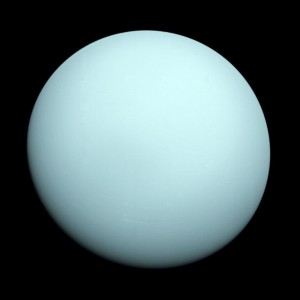Weird Planetary Science: Why Uranus Is So Intriguing
 A view of Uranus taken by the spacecraft Voyager 2 in 1986.
A view of Uranus taken by the spacecraft Voyager 2 in 1986. Uranus is a really weird planet in our solar system. Yet, it is also an archetypal planet among the many recently discovered exoplanets (planets circling stars other than our own sun). It seems that small, rocky planets like our own are much harder to find than the icy gas giants like Jupiter, Saturn, Uranus, and Neptune. Nearly every exoplanet system discovered, even those without rocky planets, seems to have at least one gas giant. Understanding how these types of planets form gives clues to how all solar systems develop.
When we think of the inside of a planet like Earth, we often think of the “onion model” in which we imagine a cutaway of our globe showing layers below the crust of mantle and core. This sort of analogy breaks down for gas giants. While all the ones in our solar system have solid cores, the transition between the gas we observe on the outside and the solid forming the core is not so clean. The boundaries between gas and liquid and solid are blurry at best. Trapped within a gas giant’s boundaries are ancient materials left over from the formation of the solar system. While the inner rocky planets were whacking into each other and getting whacked by asteroids and other planetesimals to accrete their current mass, the outer planets were hoovering up the leftover gas and dust still spinning around the nascent sun. Understanding these materials helps us understand the conditions under which our sun could have formed in the first place.
Leigh Fletcher of the University of Oxford and Chris Arridge from the Mullard Space Science Laboratory at the University College of London, feel the time is overdue to send a space probe to learn more about the icy gas giants in our own neighborhood. Specifically, they would like to send a mission to learn more about Uranus. The mission is still in the proposal phase and based mostly on the earlier proposed Uranus Pathfinder mission (much of the science team is the same, and many of its basic goals are similar). Of course, since the team has until 2015 to submit their mission plan to European Space Agency (ESA), the details will be in flux until that time.
So why Uranus? As this team knows from firsthand experience, Jupiter and Saturn have had plenty of attention. Planned for launching in 2022, the JUICE (JUpiter ICy moons Explorer) mission will visit Jupiter’s moons Ganymede, Callisto, and Europa. Still going well after its planned mission life, Cassini-Huygens (with Fletcher on the science team) has been exploring Saturn and its moons for over a decade. That leaves Neptune and Uranus. When selecting something to study, scientists always want to look at the weird, since it is in the exceptions to our understanding that we learn new things. On those grounds Uranus wins hands down.
Unlike any other planet in our solar system, Uranus’s axis of rotation, at 97 degrees, is tilted nearly on its side, with its north pole pointing almost directly at the sun. Winter on Uranus lasts forty-two years. Even weirder, while the orbits of Uranus’s moons are tilted like the axis of their mother planet, the axis of Uranus’s rings remains on plane with the orbital plane on which Uranus transits around the sun. The atmospheric convection patterns are also totally out of whack. While Neptune shows the same raging winds we would expect to see on a gas giant, conditions on Uranus appear much calmer—except for the springtime storms that can whirl in size comparable to that of all of North America. Both Neptune and Uranus have magnetic fields, but again, Uranus’s is weird. Planets form magnetic fields when conducting material inside them rotates. The axes of the dipole field are not always perfectly lined up with the axis of a planet’s rotation—hence Earth’s difference of 11.5 degrees between “true north”—our rotation axis—and the magnetic north our compasses point to. On Uranus, this difference is 58.6 degrees. Weird, but why are these particular weird things of scientific interest?
First of all, the strange axis of rotation has long been thought to be the result of a collision with some other large body of matter—large, as in Earth-sized large. However, this theory fails to explain why Uranus’s rings are not also tilted. In 2009 a new theory was developed which may better explain the tilt. While this theory requires Uranus to have one more moon than it currently does—the theory explains how this missing moon would have been ejected from orbit after tugging Uranus onto its side—it also helps explain how other planetary formation models insist that Uranus is one moon short of what we expect to see. Second is the weather. Planetary weather is always interesting to scientists because it helps us better understand our own weather and the climate patterns they eventually form. And finally, there’s that weird magnetic field. Uranus’s magnetic center is not aligned with its geographic center.
Also—unlike Earth—the magnetic field has a quadrupole component in addition to the usual dipole. This causes extreme variations in the strength of the magnetic field at different points on Uranus’s globe. One theory posits that the conducting material at the source of Uranus’s magnetic field generation is not its core but a spinning, salty ocean. Still, that fails to explain why Uranus’s magnetosphere—the effect on the solar wind of the magnetic field of a planet—is…normal.
Weird.
